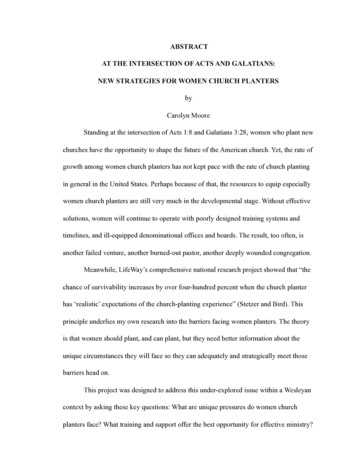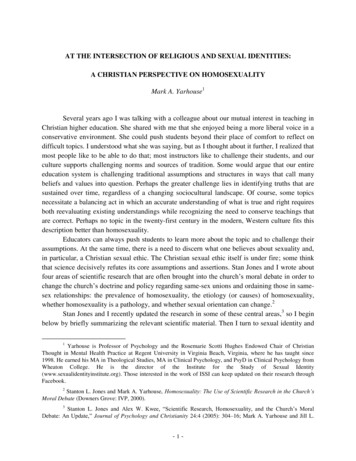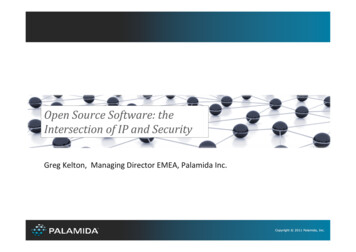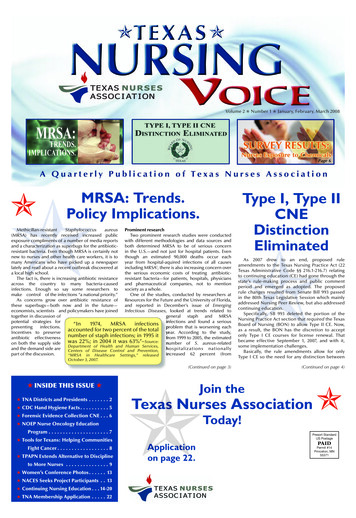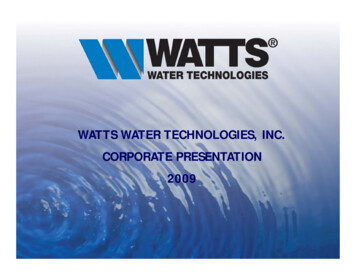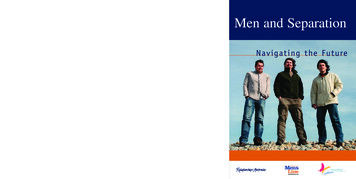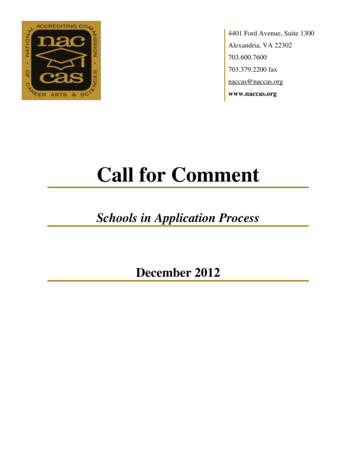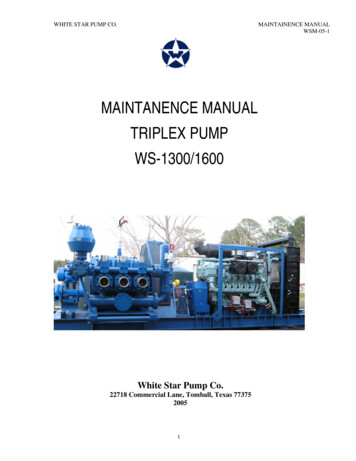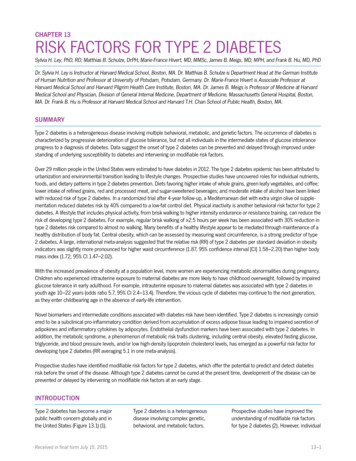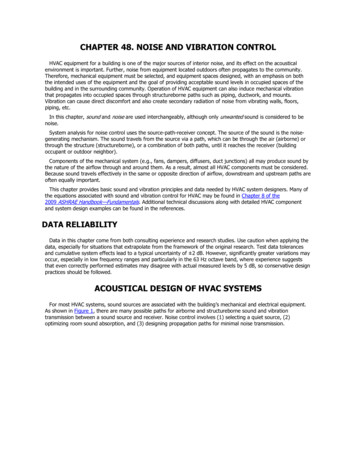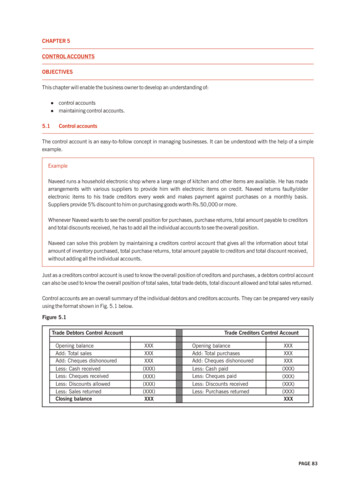
Transcription
Chapter .07Intersection Control TypeGeneralIntersection Control ObjectivesCommon Types of Intersection ControlModal 0.01 GeneralIt is WSDOT practice to analyze potential intersection solutions at all intersection improvementlocations in accordance with E 1082 – Business Practices for Moving Washington and E 1090 –Moving Washington Forward: Practical Solutions. The objective is to provide the optimumsolution within available resources, with an emphasis on low-cost investments. The analysis canbe done for individual intersections, or on a corridor or network basis. This chapter providesguidance on preliminary intersection analysis and selection of control type. Intersection designis completed using Chapter 1310 for the geometrics of intersections, Chapter 1320 forroundabouts, and Chapter 1330 for traffic signals. Use the aforementioned chapters inconjunction with chapters 1106, 1230 series, 1430, 1510, and 1520 to assist with dimensioningdesign elements.Consider design users and the balance between modes, safety and mobility performanceconsiderations, context-sensitive/sustainable design, and economics when selecting andevaluating alternatives to meet the needs of the project.Identification of intersection projects can come from a variety of programs and sources,including those funded by local agencies and developers. The intent of this chapter is that theprocedures apply to all types of intersection modifications on the state highway system.Potential safety project locations are identified through the safety priority programmingprocess. Other programs may identify intersection needs through the priority programmingprocess, but the influence of the type of intersection control with respect to specificperformance category needs may not be fully understood until contributing factors analysis iscompleted (see Chapter 1101).Complete an Intersection Control Evaluation (ICE), formerly known as Intersection ControlAnalysis (ICA), as early as practicable, taking into account the level of community engagementthat may need to occur prior to approval. The ICE (see 1300.05 for procedures) should beconsidered a working document that is initiated no later than the scoping phase so that thescope and schedule are compatible with the chosen intersection type. Scale the ICE accordingto the size and complexity of the project; for example, evaluation of adding a turn lane to anexisting intersection control may take less effort than evaluating new intersection control.Consult the region or HQ Traffic offices for assistance with the level of effort required.It is WSDOT policy to focus on lower cost solutions with the intent to optimize return oninvestment. Only when all at-grade intersection alternatives are ruled out, including turnrestrictions and complete intersection removal, should other more-costly measures beconsidered, such as grade-separation. Ramp terminal intersections are subject to the analysisrequirements of this chapter. See chapters 1360 and 550 for additional information.WSDOT Design Manual M 22-01.15July 2018Page 1300-1
Intersection Control TypeChapter 1300For additional information, see the following 013101320133013401360151015151520SubjectTraffic analysisSustainable Safety AnalysisLimited access controlManaged access controlAccess Revision ReportPractical DesignNeed IdentificationDesign ControlsDesign Element DimensioningGeometric Cross Section Basics; and other 1230 series chaptersIntersectionsRoundaboutsTraffic signalsDrivewaysInterchangesPedestrian facilitiesShared-use pathsBicycle facilities1300.02 Intersection Control ObjectivesIntersections are an important part of highway design. Intersection control choice requiresconsideration of all potential users of the facility, including drivers of motorcycles, passengercars, heavy vehicles of different classifications, public transit, and bicyclists and pedestrians.Design users have varying skills and abilities. Younger and older drivers in particular are subjectto a variety of behavioral or human factors that can influence elements of their driving ability.See NCHRP Report 600 – Human Factors Guidelines for Road Systems: Second Edition foradditional information (http://www.trb.org/Main/Blurbs/167909.aspx). Bicyclists, fromrecreational to commuters, also have a variety of skill sets that can influence the effectivenessof bike facilities and intersection operational design (see Chapter 1520 for additionalinformation). Meeting the needs of one user group can directly influence the service that othergroups experience. The selection process evaluates these competing needs and results in anoptimal balance of tradeoffs for all design users, recognizing the context and priorities of thelocation.The intent of an ICE is not to design an intersection, but to evaluate the compatibility ofdifferent intersection control types with respect to context, modal priority, intersection designvehicle, and the identified balance of performance needs. Four basic intersection designconsideration categories are shown in Exhibit 1300-1 and can affect the intersection controltypes depending on the situation.The objectives of the ICE are to: Provide a consistent framework to determine the most compatible intersection controltype for the location, context, economics, and balance of performance needs. Evaluate the operational and safety performance for various appropriate and feasibleintersection control types under consideration.Page 1300-2WSDOT Design Manual M 22-01.15July 2018
Chapter 1300Intersection Control Type Evaluate the modal performance considerations between different intersection controltypes with respect to the identified modal priority and intersection design vehicle (seeChapter 1103). Identify the potential modal treatments that augment the controltypes. Consider the intersection operations and the relationship with adjacent intersectionsand other access points. Evaluate the intersection control types for potential sustainability, community value,and expected maintenance and operation needs. Include roundabouts in all intersection control evaluations due to their safety,operational, and sustainability benefits. Consider emerging alternative intersection designs such as displaced left-turn (DLT)and restricted crossing u-turn intersections (RCUT) where appropriate. Select the intersection control type for the project based on overall need and context.WSDOT Design Manual M 22-01.15July 2018Page 1300-3
Intersection Control TypeExhibit 1300-1Chapter 1300Intersection Design ConsiderationsHuman Factors Driving habitsDriver workloadDriver expectancyDriver errorDriver distractionsPerception-reaction time Conformance to natural paths ofmovementPedestrian use and habitsBicycle traffic use and habitsVisual recognition of roadway cuesCompatibility with context characteristicsDemand for alternative mode choices Vehicle size and operating characteristicsVehicle speedsTransit involvementCrash ExperienceBicycle movementsPedestrian movements Traffic control devicesIlluminationRoadside design featuresEnvironmental factorsCrosswalksTransit facilitiesDrivewaysStreetside design featuresAdjacent at-grade rail crossingAccess management treatments includingturn restrictions Traffic Considerations Design users, modal priority, andintersection design vehicleDesign and actual capacitiesDesign-hour turning movementsVariety of cal Elements Character and use of abutting propertyVertical alignments at the intersectionSight distanceAngle of the intersectionConflict areasSpeed-change lanesManaged lanes (HOV, HOT, shoulder)Accessible facilitiesParking zonesGeometric design featuresEconomic Factors Cost of improvements, annual maintenance, operations and life cycle costs, and salvage valueEffects of controlling access and right of way on abutting properties where channelizationrestricts or prohibits vehicular movementsEnergy consumption and emissionsPage 1300-4WSDOT Design Manual M 22-01.15July 2018
Chapter 1300Intersection Control Type1300.03 Common Types of Intersection Control1300.03(1)Uncontrolled Intersections Uncontrolled intersections do not have signing, andthe normal right of way rule (RCW 46.61.180) applies. This intersection type is typically found on local roadsand streets where the volumes of the intersectingroadways are low and roughly equal, speeds are low,and there is little to no crash history. Uncontrolled intersections are not recommended forstate routes.1300.03(2)Yield Control Intersections with yield control assign right of way withoutrequiring a stop. Mostly used at rural low-volume ramps and wye (Y) intersections. Yield control is generally not recommended in urban locations orwhere pedestrians are expected.1300.03(3)Two-Way Stop Control Intersections with two-way stop control are a common, lower cost control, whichrequire the traffic on the minor roadway to stop and yield to mainline traffic beforeentering the major roadway. Along certain corridors, especially where u-turn opportunities exist, consider limitingaccess at two-way stops to “right-in, right-out only.”1300.03(4)Multi-Way Stop Control Multi-way stop control normally requires alltraffic to stop before entering the intersection. Fewer fatal and injury crashes than two-waystop control. Multi-way stop control is suited for lowerspeed facilities with approximately equalvolumes on all legs and total entering volumesnot exceeding 1,400 vehicles during the peakhour. Increased traffic delays, fuel consumption, andair pollution. Multi-way stop control is not recommended on multilane state routes or atintersections with unbalanced directional traffic flows because of the delays andqueues introduced on the major-volume legs of the intersection.WSDOT Design Manual M 22-01.15July 2018Page 1300-5
Intersection Control Type1300.03(5)Chapter 1300RoundaboutsRoundabouts are often circular (or near-circular) at-grade intersections, where traffic on theapproaches yield to traffic within the circulating roadway. Roundabouts are an effectiveintersection type that may offer the following: Reduced fatal and injury crashes comparedwith other at-grade intersection types. Fewer conflict points. Lower potential for wrong-way driving. Reduced traffic delays. Traffic-calming and lower speeds. More capacity than a two-way or multiway stop. Quickly serves pedestrians needing tocross the intersection and shortenscrossing distance for pedestrians by allowing for crossing in stages using splitter islandsas pedestrian refuges. Reduced vehicular approach speeds that result in reduced crash and severity potentialto pedestrians. Ability to serve high turning volumes with minimal number of approach lanes. Improved operations where space for queuing is limited. Improved capacity at ramp terminals intersections with high left-turn volumes withoutaffecting the structure. Facilitation of u-turn movements and can be appropriate when combined with accessmanagement along a corridor. Aesthetic treatments and gateways to communities. Flexibility to fit funding and a variety of site constraints. Roundabouts are scalable andsite-specific solutions. See Chapter 1320 for more information on roundabout typesand design.1300.03(6)Traffic Control SignalsSignalized intersections may offer the following: Increased capacity of the intersection compared to stop-controlled intersections. Allow for improved progression within a coordinated system along a corridor or a grid. Can be used to interrupt heavy traffic at intervals to permit other traffic, vehicular orpedestrian, to complete their movement or enter the intersection. Can be preempted to provide priority service to railroad, emergency responders,transit and approaches where advance queue loops are used. Reduced at-angle vehicle crashes compared to stop-controlled intersections.However, signalized intersections: Require continual maintenance and engineering for optimal operations.Page 1300-6WSDOT Design Manual M 22-01.15July 2018
Chapter 1300Intersection Control Type Cannot adequately balance large traffic flows with pedestrian demands. Can be susceptible to power outages and detection failures. Increase rear-end crashes.Indiscriminate use of traffic signals can adversely affect the safety performance and operationalefficiency of vehicle, bicycle, and pedestrian traffic. Therefore, and as required by the MUTCD, atraffic signal should be considered for installation only after if it is determined to meet specific“warrants” and an engineering study shows that the installation would improve safety and/oroperations. Satisfying a signal warrant does not mandate the installation of a traffic signal nor byitself meet the requirements of 1300.05; but failing to satisfy at least one warrant shall removethe signal from consideration.Not all crashes are correctable with the installation of a traffic signal. Traffic signals maydecrease the potential for crashes of one type and increase the potential for another type. Forinstance, at-angle crashes are less frequent with signals because the traffic movements arecontrolled, but rear-end crashes are more frequent with signals because of stopping and startingof vehicles. At-angle crashes are usually more severe than rear-end crashes; however, theseverity of these rear-end crashes tend to be higher at operating speeds above 40 mph. Thisrequires careful consideration of the location characteristics, traffic flow, and crash history.State statutes (RCW 46.61.085) require WSDOT approval for the design and location of allconventional traffic signals and for some types of beacons located on city streets forming partsof state highways. The Traffic Signal Permit (DOT Form 242-014 EF) is the formal record of thedepartment’s approval of the installation and type of signal. For traffic signal permit guidance,see Chapter 1330.1300.03(7)Alternative IntersectionsAlternative intersections work mainly by rerouting U and left turns, and/or separatingmovements. Alternative intersections may have different terminology in different areas, but themost common types include: Median u-turn Split intersection Jug handle Quadrant roadway intersection Bowtie Single quadrant interchange Restricted crossing u-turn Echelon Displaced left-turn intersection Center turn overpass Continuous green teeAs alternative intersections may be relatively new to Washington State and its users, moreeducation and community engagement will be necessary to help ensure project success.However, extensive experience shows that many of these intersection types can provide betteroperational and safety performance, often at much less cost than traditional strategies.Three types of alternative intersections are highlighted in the subsections below: median u-turn,restricted crossing u-turn, and displaced left-turn intersections. For more information aboutthese and other intersection design solutions, see the Federal Highway Administration (FHWA)Alternative Intersection Design web page:http://safety.fhwa.dot.gov/intersection/alter design/WSDOT Design Manual M 22-01.15July 2018Page 1300-7
Intersection Control TypeChapter 13001300.03(7)(a) Median U-Turn (MUT)The MUT intersection treatment relocates left turn movements downstream from theintersection resulting in lower delays, higher throughput, and reduction in the number andseverity of crashes. Left-turning drivers proceed straight through the at-grade intersection, andthen execute a u-turn at some distance downstream at a new or existing median opening. Themain intersection is typically signalized and can be highly efficient needing only two signalphases. By removing the left turns at the main intersection, the MUT design results in asignificant reduction in rear-end, angle, and sideswipe crashes; while reducing the number ofconflict points from 32 to 16 when compared to a conventional signalized intersection. The MUTcan also have advantages for pedestrians with fewer conflict points and a lower delay. However,the intersection design may reduce bicyclist mobility as they are expected to use the pedestriancrossings in order to perform left turns at the intersection. The MUT intersection design is morelikely to be suitable for consideration in situations where: The intersection is over capacity. There are heavy through volumes and low to moderate left turn volumes. The intersection is within a higher-speed, multilane, median-divided corridor. There are safety concerns at an existing signalized intersection or corridor.Refer to FHWA’s Median U-Turn Intersection Informational Guide for geometric designconsiderations and recommendations. (See Chapter 1310 for geometrics when designing theu-turn movement for the MUT intersection.)Exhibit 1300-2Median U-Turn Intersection ExampleMUT Intersection from FHWA’s Median U-Turn Intersection Informational GuidePage 1300-8WSDOT Design Manual M 22-01.15July 2018
Chapter 1300Intersection Control Type1300.03(7)(b)Restricted Crossing U-Turn Intersection (RCUT)RCUT intersections, also known as superstreets or J-turns, have similarities with the MUT in thatthe minor road left-turning movements are redirected (see Exhibit 1300-2). RCUTs, however,also redirect minor road through movements as shown in Exhibit 1300-3. This intersection typeresults in lower delays, improved progression, and a potential reduction in the total number ofcrashes and fatal and injury crashes.Drivers on the minor road approaches must turn right onto the major road and then perform au-turn maneuver at a median opening downstream. However, the major road left turnmovements may still be allowed at the main intersection. RCUT intersections may or may notwarrant signalization due to traffic volumes, and those with signalization require fewer signalphases and shorter cycle lengths than a traditional signalized intersection. The RCUTintersection is more likely suitable for consideration in situations where: The intersection is over capacity. There is a need to improve travel time and progression for the major road. There are crashes at the intersection related to turning movements that can bereduced by a RCUT. The intersection is within a higher-speed, multilane corridor. There are low through and left turn volumes on the minor road. Pedestrian volumes are low. The major roadway contains sufficient median width, or total right of way width, tosupport the u-turn movements.Exhibit 1300-3Restricted Crossing U-Turn Intersection Example with Stop-controlExample of RCUT Intersection with stop-control from FHWA’s Restricted Crossing U-Turn Intersection Informational GuideThe RCUT intersection may be a potential alternative compared to a grade-separatedinterchange, at locations meeting grade-separated considerations identified in 530.04(3). Referto FHWA’s Restricted Crossing U-Turn Intersection Informational Guide for geometric designconsiderations and recommendations. (See Chapter 1310 for geometrics when designing theu-turn movement for the RCUT.)WSDOT Design Manual M 22-01.15July 2018Page 1300-9
Intersection Control Type1300.03(7)(c)Chapter 1300Displaced Left-Turn Intersection (DLT)The DLT intersection, also known as a continuous flow intersection, works mainly by relocatingone or more left turn movements to the other side of the opposing traffic via an interconnectedsignalized crossover. This essentially causes the traffic signal system to be more efficient byeliminating the left turn phase at the main intersection allowing for more green time to beallocated to other movements. The DLT can reduce delays by up to 40%, but often can bedelivered for just slightly more cost than a typical signalized intersection. Compared with aconventional intersection, the DLT can be more challenging for pedestria
WSDOT Design Manual M 22-01.15 Page 1300-1 July 2018 Chapter 1300 Intersection Control Type 1300.01 General. 1300.02 Intersection Control Objectives. 1300.03 Common Types of Intersection Control. 1300.04 Modal Considerations. 1300.05 Procedures. 1300.06 Do
